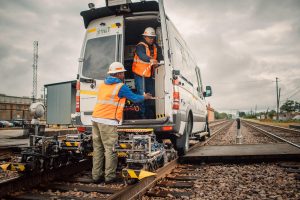
The U.S. Federal Railroad Administration (FRA) has submitted to the Federal Register a final rule allowing railway companies to use ultrasonic inspection technology, augmented with GPS technology, to employ continuous rail testing.
These updated regulations are expected to improve safety by making it easier for railways to test rail more frequently and to identify and repair internal rail flaws before conditions degrade safety. This regulatory reform allows rail testing vehicles to move without stopping along the track, potentially decreasing passenger and freight train delays associated with routine inspections.
Fast-developing technologies challenge regulators to craft and revise regulations that help ensure public safety, while allowing railroads to test and implement innovative inspection methods.
In the past 10 years FRA has issued waivers allowing larger railway operators to develop and use this ultrasonic inspection technology, and the updated standards are consistent with the state of the practice.
In 2019 – 2020, there has been a 27% reduction in broken rail-caused train accidents, which is largely attributable to this new technology. Providing all companies the option of using this technology presents an opportunity to improve the industry’s overall safety record.
The Final Rule on rail integrity amendments and track safety standards focuses more on providing performance-based outcomes, rather than prescribing exactly how companies conduct effective tests. Railway companies will be expected to use established methods to conduct required rail inspections, but they will also have the flexibility to use new technologies and methods as they are proven safe and effective.
Continuous rail testing involves rail cars outfitted with ultrasonic and GPS technologies to internally examine rail without stopping. These cars travel along track, collecting detailed imaging and location data. Companies then transmit the information to test monitoring sites where analysts scrutinise the data to identify suspected internal rail defects. Depending on the severity of the potential defect, carriers have between 36 and 84 hours to dispatch teams to the site to inspect the rail.
Current regulations require ultrasonic rail test vehicles to repeatedly stop and manually inspect to verify indication of defects within four hours. This frequent starting and stopping can require trains operating in the vicinity to travel at slower speeds, often delaying passenger and freight traffic.
Using the existing methods, companies are typically able to test about 30 km of track per day. By contrast, companies employing continuous rail testing are typically able to test 130- to 257 km of track daily.
FRA estimates that one continuous rail car could replace three to five stop-and-verify test cars. This equates to fewer test cars stopping on tracks, reducing the number of trains that slow to accommodate them. Fewer trains slowing decreases the likelihood of crews exceeding maximum allowable work hours, thus decreasing the expense of unscheduled replacement crews. According to estimations, the continuous rail testing could save the industry USD 121.9 million in 10 years.
Share on:



